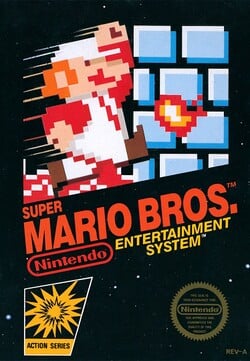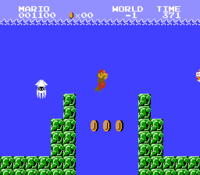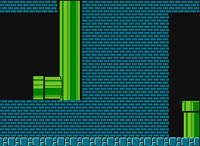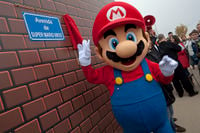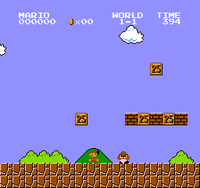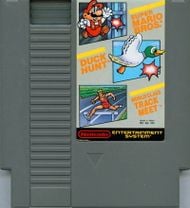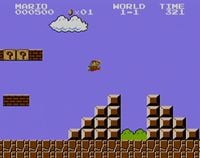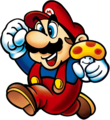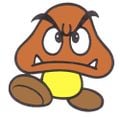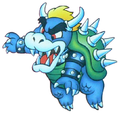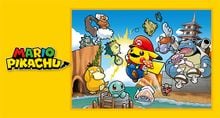Super Mario Bros.
- "SMB" redirects here. For the game known in Japan and Europe as Super Mario Ball, see Mario Pinball Land.
- "Super Mario Brothers" redirects here. For the microgame from WarioWare: Smooth Moves, see Super Mario Brothers (WarioWare: Smooth Moves).
- Not to be confused with Mario Bros. (game) or New Super Mario Bros.
- This article is about the video game originally published for the Nintendo Entertainment System. For further uses, see Super Mario Bros. (disambiguation).
Super Mario Bros. is a video game released for the Family Computer and Nintendo Entertainment System in 1985. It shifted the gameplay away from its single-screen arcade predecessor, Mario Bros., and instead featured side-scrolling platformer levels. While not the first game of the Mario franchise (the first being Donkey Kong), Super Mario Bros. is the most iconic, and introduced various series staples, including power-ups, classic enemies such as Goombas, and the basic premise of rescuing Princess Peach from Bowser.
As well as kicking off an entire series of Super Mario platformer games, the wild success of Super Mario Bros. popularized the genre as a whole, helped revive the North American gaming industry after the video game crash of 1983, and was largely responsible for the initial success of the NES, with which it was bundled as a launch title. Until it was eventually surpassed by Wii Sports, Super Mario Bros. was the best-selling video game of all time for nearly three decades, with over 40 million copies sold worldwide.
The exact day of the North American release of Super Mario Bros. is heavily disputed, with different sources giving different dates with no way to verify them. Regardless, Nintendo officially pinpoints the release date as October 18, 1985.[1]
A successor named Super Mario Bros. 2 in Japan (later renamed Super Mario Bros.: The Lost Levels in North America) was released on June 3, 1986. Another successor sharing its English name with its predecessor's Japanese name was released on October 9, 1988. A third successor named Super Mario Bros. 3 was released on October 23, 1988.
Super Mario Bros. has been ported to many consoles. It was one of the NES games that could be played on the Nintendo PlayChoice-10 and NES Classic Edition, and it was released on the Wii, Wii U, and Nintendo 3DS Virtual Console and on Nintendo Switch's Nintendo Entertainment System - Nintendo Switch Online.
Story
The following text is taken directly from the NES instruction booklet localization.
One day the kingdom of the peaceful mushroom people was invaded by the Koopa, a tribe of turtles famous for their black magic. The quiet, peace-loving Mushroom People were turned into mere stones, bricks and even field horsehair plants, and the Mushroom Kingdom fell into ruin.
The only one who can undo the magic spell on the Mushroom People and return them to their normal selves is the Princess Toadstool, the daughter of the Mushroom King. Unfortunately, she is presently in the hands of the great Koopa turtle king.
Mario, the hero of the story (maybe) hears about the Mushroom People's plight and sets out on a quest to free the Mushroom Princess from the evil Koopa and restore the fallen kingdom of the Mushroom People.
You are Mario! It's up to you to save the Mushroom People from the black magic of the Koopa!
One day, the Mushroom Kingdom was invaded by the Turtle Tribe, whose king was capable of using powerful magic. This magic was used to transform all the Mushroom People into inanimate objects such as rocks, bricks, and even horsetails, thus spelling the kingdom's downfall. Only Princess Toadstool can undo the spell and restore her people to life, but she is being held captive by King Koopa himself. Mario, who had emerged in the Mushroom Kingdom through a clay pipe from New York City,[2] hears of the princess's plight, and sets out on a quest through 32 stages to topple the Turtle Tribe and save the once-peaceful kingdom.[3]
Gameplay
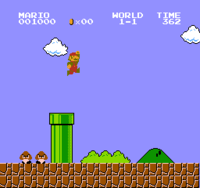
Super Mario Bros. is divided into eight worlds, each of them containing four levels. Mario (or, in the case of a second player, his brother Luigi) has to get to the end of the level by jumping over various gaps and avoiding the enemies on his way. He can use several platforms (some of them collapse when Mario lands on them), stairs in the level, as well as jumping boards. There are also pipes along the way, some of which Mario can enter to visit various secret coin rooms before returning to the level, a bit further ahead than when he left.
Enemies include Little Goombas, Koopa Troopas, Buzzy Beetles, Koopa Paratroopas, Bullet Bills, Hammer Brothers, and leaping Cheep-cheeps. All these enemies can be defeated when Mario jumps on them. Koopa Troopas and Buzzy Beetles cower in their shell when jumped on, which Mario can kick to defeat other enemies with. Koopa Paratroopas lose their wings and fall to the ground when Mario jumps on them. Other enemies include Piranha Plants, and the Spiny-throwing Lakitus, and Mario has to either shoot fireballs at them or just avoid them. Two levels take place underwater. In the water, Mario can swim freely from the top to the bottom of the screen. The enemies in underwater levels are Bloobers and Cheep-cheeps. Mario can only defeat these creatures by shooting them with fireballs.
If regular Mario takes a hit, falls down a pit, or if the Time Limit runs out, he loses a life and restarts the level. The point where Mario continues depends on how far he ran through the level before getting defeated; either from the beginning or at one of several invisible "checkpoints" throughout the level. After a Game Over, pressing while holding
on the title screen allows the player to continue from the start of the world.[4] In a 2-player game, if this is done by whoever got a Game Over second, both players will begin in the same world where the second player's game ended.
Mario can get special power-ups out of ? blocks or, uncommonly, bricks. Most of the ?s in which Mario can find these items are visible, but some are hidden and only become visible when Mario hits them from beneath. With the Magic Mushroom, he turns into Super Mario. As Super Mario, he can survive the hit of an enemy one time, at the cost of turning back to regular Mario. He may also destroy empty bricks by jumping beneath them. Additionally, he can also get the Fire Flower. With the Fire Flower, Super Mario turns into Fiery Mario, which allows him to shoot fireballs at enemies to defeat them from a distance. With the 1 up Mushroom, he gains an additional life; he can also get an extra life if he collects a hundred coins. With the Starman, which can only be found in bricks, Mario turns invincible for a short amount of time and can defeat enemies by simply touching them. With the exception of coins, only one item can appear on the screen, and when a new item appears, the previous one will disappear.
At the end of each level, a castle stands with a flagpole nearby. When Mario reaches the flagpole, he takes down the enemy flag and enters the castle, completing the level. The higher the spot that Mario hits the flagpole, the more points he receives. If two players are playing the game, Luigi's turn comes whenever Mario loses a life. Luigi has no special abilities in the game that are different from Mario's.
The fourth level of each world plays inside a castle. They are usually filled with Fire-Bars and Podoboos. At the end of a castle level, Mario is confronted with a fake Bowser in Worlds 1 through 7 and the actual Bowser in World 8. Mario and Luigi ordinarily have no way to hurt the fake Bowsers or the actual Bowser and have to either use the ax to destroy the bridge, causing either the false or real one to fall into the lava, or pelt him with many fireballs, which produces the same result and reveals the true forms of the fakes. After defeating an impostor, Mario frees one of the seven remaining mushroom retainers from the castle, at which point they say their iconic phrase: "Thank you, Mario! But our princess is in another castle!" At the end of the castle in World 8, Mario frees the grateful Princess Toadstool and completes his adventure, having the choice to continue playing in a "new quest." In this second quest, the player gets to choose a world, and replay some levels. However, all Little Goombas are replaced by Buzzy Beetles, all ground enemies are also considerably faster, some platforms and elevator-style lifts are shortened in length, and the level design is slightly changed for some levels (see below at "Hard mode").
Controls
The controls can be customized on Wii U Virtual Console.
NES Controller / NES Classic Controller / Nintendo Switch Online NES Controller
(left and right): Move; change position on a beanstalk
(down): Duck; enter Warp Pipe
(up and down): Climb beanstalk
: Jump; swim upwards
: Dash; throw fireball; restart the game at the end; select a world
: Pause; confirm selected option on title screen
: Select number of players on title screen
- Press
while holding down
: Continue in the same world after the Game Over screen
Wii Remote
 : Move; change position on beanstalk
: Move; change position on beanstalk : Duck; enter Warp Pipe
: Duck; enter Warp Pipe : Climb beanstalk
: Climb beanstalk : Jump; swim upwards
: Jump; swim upwards : Dash; throw fireball
: Dash; throw fireball : Pause
: Pause- Press
 while holding down
while holding down  : Continue in the same world after the Game Over screen
: Continue in the same world after the Game Over screen
Wii Classic Controller
(left and right) or
 : Move; change position on beanstalk
: Move; change position on beanstalk(down) or
 : Duck; enter Warp Pipe
: Duck; enter Warp Pipe(up and down) or
 : Climb beanstalk
: Climb beanstalk : Jump; swim upwards
: Jump; swim upwards : Run; throw fireball
: Run; throw fireball : Pause
: Pause- Press
 while holding down
while holding down  : Continue in the same world after the Game Over screen
: Continue in the same world after the Game Over screen
Nintendo GameCube Controller
 (left and right) or
(left and right) or  (left and right): Move; change position on beanstalk
(left and right): Move; change position on beanstalk (down) or
(down) or  (down): Duck; enter Warp Pipe
(down): Duck; enter Warp Pipe (up and down) or
(up and down) or  (up and down): Climb beanstalk
(up and down): Climb beanstalk : Jump; swim upwards
: Jump; swim upwards : Run; throw fireball
: Run; throw fireball : Pause
: Pause- Press
 while holding down
while holding down  : Continue in the same world after the Game Over screen
: Continue in the same world after the Game Over screen
Game Boy Advance
 (left and right): Move; change position on beanstalk
(left and right): Move; change position on beanstalk (down): Duck; enter Warp Pipe
(down): Duck; enter Warp Pipe (up and down): Climb beanstalk
(up and down): Climb beanstalk : Jump; swim upwards
: Jump; swim upwards : Run; throw fireball
: Run; throw fireball: Pause
- Press
while holding down
 : Continue in the same world after the Game Over screen
: Continue in the same world after the Game Over screen
Nintendo 3DS
(left and right) or
and
: Move; change position on beanstalk
(down) or
: Duck; enter Warp Pipe
(up and down) or
and
: Climb beanstalk
: Jump; swim upwards
: Run; throw fireball
: Pause
- Press
while holding down
: Continue in the same world after the Game Over screen
Wii U GamePad / Wii U Pro Controller (default)
(left and right) or
 and
and  : Move; change position on beanstalk
: Move; change position on beanstalk(down) or
 : Duck; enter Warp Pipe
: Duck; enter Warp Pipe(up and down) or
 and
and  : Climb beanstalk
: Climb beanstalk : Jump; swim upwards
: Jump; swim upwards : Run; throw fireball
: Run; throw fireball : Pause
: Pause- Press
 while holding down
while holding down  : Continue in the same world after the Game Over screen
: Continue in the same world after the Game Over screen
Joy-Con (pair)/ Nintendo Switch Pro Controller
(left and right) or
and
: Move; change position on beanstalk
(down) or
: Duck; enter Warp Pipe
(up and down) or
and
: Climb beanstalk
: Jump; swim upwards
: Run; throw fireball
: Pause
- Press
while holding down
: Continue in the same world after the Game Over screen
Joy-Con (sideways)
(left and right): Move; change position on beanstalk
(down): Duck; enter Warp Pipe
(up and down): Climb beanstalk
: Jump; swim upwards
: Run; throw fireball
/
: Pause
- Press
/
while holding down
: Continue in the same world after the Game Over screen
Characters
Playable characters
Supporting characters
Enemies
| Name | Sprite | Description |
|---|---|---|
| Bloober | A squid-like sentry that persistently pursues the player. | |
| Bullet Bill | A slow but steady bullet that has eyes and arms. They come from Turtle Cannons, and the only way to defeat them is to stomp on them or hit them while under the influence of a Starman. | |
| Buzzy Beetle | A small turtle that hides in its shell when jumped on, just like Koopa Troopas; unlike them, however, it is immune to fireballs. They replace Little Goombas in Hard Mode. | |
| Cheep-cheep | A red or gray fish normally found swimming in water. Gray ones are slightly slower. In certain levels, starting with World 2-3, the red ones will leap from the water, trying to hit Mario or Luigi. | |
| Fire-Bar | 
|
Various fireballs stacked together moving either clockwise or counterclockwise. Their length may vary. |
| Hammer Brother | A green biped, helmeted Koopa that comes in a pair. They throw an endless number of hammers towards Mario and at certain times they jump. | |
| Koopa Paratroopa | A Koopa Troopa with wings. Green ones (which appear blue-green underground and in castles) jump towards the player or fly back and forth, while red ones fly up and down. | |
| Koopa Troopa | A soldier of the Turtle Empire that marches onwards. If stomped, it retreats in its shell, which can be kicked to hit other enemies and gain points. Green ones (which appear blue-green underground and in castles) walk back and forth just like Little Goombas, and red ones turn around when they find a pit. | |
| Lakitu | A bespectacled Koopa hiding in a small cloud. It throws an infinite number of Spiny's eggs towards the player. | |
| Little Goomba | A mushroom traitor that walks back and forth. They are the weakest and most common enemies throughout the game and can be stomped or hit with fireballs or a Starman. They are replaced with Buzzy Beetles in Hard Mode. | |
| Piranha Plant | A carnivorous plant that lives in a pipe. It rises, trying to hit Mario and retreats. If Mario is near, it will not rise. | |
| Podoboo | A fireball guardian of the Koopa King's lair. It jumps from the lava, trying to hit Mario. | |
| Spiny | Lakitu's small yet tough pet with a red, spiked shell. If Mario tries to stomp it, he will get damaged. | |
| Spiny's egg | A red, spiked egg thrown by Lakitus. Once it hits the ground, it immediately hatches into a Spiny. | |
| Turtle Cannon | An indestructible cannon. It shoots an endless number of Bullet Bills; however, it does nothing if the player is near it. |
Bosses
- Fake Bowser (Worlds 1 through 7)
- Bowser, King of the Koopa (World 8)
Items
| Coin | 200 points | Very Common | Collecting 100 of them gives an extra life. | |
|---|---|---|---|---|
| Magic Mushroom | 1000 points | Uncommon | Gives the Super form. | |
| Fire Flower | 1000 points | Uncommon | Gives the ability to shoot fireballs. | |
| Starman | 1000 points | Rare | Gives invincibility for a moment. | |
| 1 up Mushroom | 0 points | Rare | Gives an extra life. |
Transformations
| Mario | Requires touching an enemy or obstacle while in Super or Fiery form |
| |
|---|---|---|---|
| Super Mario | Requires Magic Mushroom or Fire Flower while in regular form |
| |
| Fiery Mario | Requires Fire Flower while in Super form |
| |
| Invincible Mario | Requires Starman |
| |
List of levels
| World | Level | Setting | Enemies found |
|---|---|---|---|
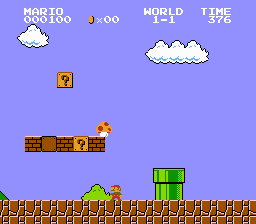 |
World 1-1 | Overworld | Little Goomba, Koopa Troopa |
| World 1-2 | Underground | Little Goomba, Koopa Troopa, Piranha Plant | |
| World 1-3 | Athletic | Little Goomba, Koopa Troopa, Koopa Paratroopa | |
| World 1-4 | Castle | Fire-Bar, fake Bowser (Little Goomba) | |
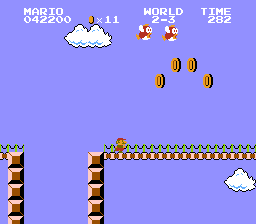 |
World 2-1 | Overworld | Little Goomba, Koopa Troopa, Koopa Paratroopa, Piranha Plant |
| World 2-2 | Underwater | Bloober, Cheep-cheep, Piranha Plant | |
| World 2-3 | Athletic | Cheep-cheep | |
| World 2-4 | Castle | Fire-Bar, Podoboo, fake Bowser (Koopa Troopa) | |
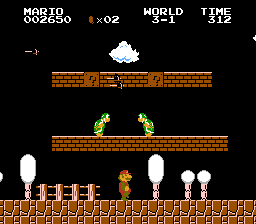 |
World 3-1 | Overworld | Little Goomba, Koopa Troopa, Koopa Paratroopa, Piranha Plant, Hammer Brother |
| World 3-2 | Overworld | Little Goomba, Koopa Troopa, Koopa Paratroopa, Piranha Plant | |
| World 3-3 | Athletic | Little Goomba, Koopa Troopa, Koopa Paratroopa | |
| World 3-4 | Castle | Fire-Bar, Podoboo, fake Bowser (Buzzy Beetle) | |
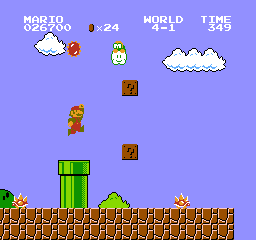 |
World 4-1 | Overworld | Piranha Plant, Lakitu, Spiny |
| World 4-2 | Underground | Little Goomba, Koopa Troopa, Piranha Plant, Buzzy Beetle | |
| World 4-3 | Athletic | Koopa Troopa, Koopa Paratroopa | |
| World 4-4 | Castle | Piranha Plant, Podoboo, Fire-Bar, fake Bowser (Spiny) | |
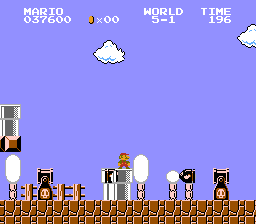 |
World 5-1 | Overworld | Little Goomba, Koopa Troopa, Koopa Paratroopa, Piranha Plant, Bullet Bill |
| World 5-2 | Overworld | Little Goomba, Koopa Troopa, Koopa Paratroopa, Piranha Plant, Buzzy Beetle, Bullet Bill, Hammer Brother (Bloober, Cheep-cheep) | |
| World 5-3 | Athletic | Little Goomba, Koopa Troopa, Koopa Paratroopa, Bullet Bill | |
| World 5-4 | Castle | Podoboo, Fire-Bar, fake Bowser (Lakitu) | |
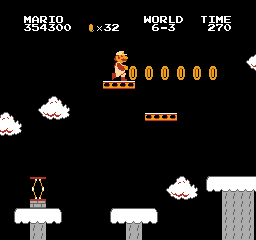 |
World 6-1 | Overworld | Piranha Plant, Lakitu, Spiny |
| World 6-2 | Overworld | Little Goomba, Koopa Troopa, Koopa Paratroopa, Piranha Plant, Buzzy Beetle (Bloober, Cheep-cheep) | |
| World 6-3 | Athletic | Bullet Bill | |
| World 6-4 | Castle | Podoboo, Fire-Bar, fake Bowser (Bloober) | |
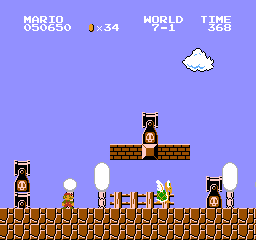 |
World 7-1 | Overworld | Koopa Troopa, Koopa Paratroopa, Piranha Plant, Buzzy Beetle, Hammer Brother, Bullet Bill |
| World 7-2 | Underwater | Bloober, Cheep-cheep, Piranha Plant | |
| World 7-3 | Athletic | Cheep-cheep, Koopa Troopa, Koopa Paratroopa | |
| World 7-4 | Castle | Podoboo, Fire-Bar, fake Bowser (Hammer Brother) | |
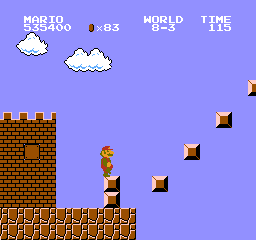 |
World 8-1 | Overworld | Little Goomba, Koopa Troopa, Koopa Paratroopa, Piranha Plant, Buzzy Beetle |
| World 8-2 | Overworld | Little Goomba, Koopa Paratroopa, Piranha Plant, Buzzy Beetle, Lakitu, Spiny, Bullet Bill | |
| World 8-3 | Overworld | Koopa Troopa, Koopa Paratroopa, Piranha Plant, Bullet Bill, Hammer Brother | |
| World 8-4 | Castle | Little Goomba, Koopa Paratroopa, Piranha Plant, Fire-Bar, Podoboo, Buzzy Beetle, Hammer Brother, Bloober, Cheep-cheep, Bowser |
Hard mode
After beating the main game, the player is given the option to pick a world (by pressing on the title screen) to play in "a new quest"—a harder mode where all Little Goombas are replaced by Buzzy Beetles, and all enemies walk faster; all of the elevator-style lifts are about sixty percent of their original size, while Fire-Bars appear in all possible locations. Mario and Luigi gain no special powers in hard mode, and they receive no extra points when they defeat an enemy. The story remains the same, as each of the first seven castles contains a mushroom retainer that needs rescuing, while the eighth castle has Princess Toadstool. If the player finishes the game on hard mode, they will not unlock anything new from the previous time the game was finished. However, points can be gained faster by jumping on a Buzzy Beetle and then running with the shell as it hits other Buzzy Beetles and Koopa Troopas. Earlier levels in hard mode are the same as their harder clones; for instance, 1-3, which is an easier version of 5-3 in the normal game, is identical to it in hard mode.
Glitches
- Main article: List of Super Mario Bros. glitches
Minus World
- Main article: Minus World
The Minus World is an endless underwater level, identical to World 7-2, which is accessed through a programming glitch. There is no way to complete the level, as entering the pipe at the end will simply return Mario or Luigi to the one at the beginning.[5] While there is no strategic advantage in performing this glitch, many find it intriguing. The glitch was removed in some remakes of the game, excluding the imports, the Virtual Console port, and Game & Watch: Super Mario Bros. The Japanese Family Computer Disk System version of the game includes a different version of the Minus World. It contains three levels that can be beaten, and once -3 is complete, the player will return to the title screen as if they had beaten the game.
To perform the glitch, Mario must go to World 1-2 and stand on top of the pipe that leads to the above-ground flag, without going in the pipe. Then he must break the second and third block from the pipe, but leave the one on the far right. Then he must stand on the left edge of the pipe (facing left) and duck. He then has to jump while in a ducking position and move right in mid-air (while still facing left). If done correctly, Mario will go through the block on the far right and the wall to the Warp Zone. Mario must then go through the pipe that would normally lead to World 2-1 or World 4-1, and Mario will enter the Minus World.
If World 2-2 or 7-2 is edited in a ROM editor so that it is possible to beat it during the underwater segment, there is a World -2, an underwater version of 3-4. If World 3-4 is edited in a ROM editor, then there is a World -3. It is also a version of 3-4, but with overworld graphics; beating World -3 takes the player to World -4, a level which is just a blank screen.
Over the Flagpole
| File info |
In some levels, it is possible to jump over the flagpole. Beyond the flag pole is nothing but an endless path. There is nothing to do; all that can be done is wait for the timer to get to zero. To do this glitch in World 1-1, right after the second pit, Mario needs to wait for the Koopa Troopa to about to fall into the pit and simultaneously jump at the top of the level right above the Koopa. After that, the Koopa will be stuck underneath the level, but the player will still be able to see it. When the Koopa starts to walk under the level, Mario should follow it to the end. Along the way, it is required to grab a Magic Mushroom. When the Koopa is halfway between the staircase and the flagpole, the player must do the glitch again and Mario will jump above the flagpole.
To do this glitch in World 3-3, at the end of the level the player must stand on the last lift until another one has completely lifted, before falling off. After that, the player must accelerate as fast as possible and jump from the far edge of the lift. The lift should not lower while doing so.[6]
There is a brick right after the fortress's or castle's first door, which stops Mario from going past the Fortress at the end of the levels.
In Super Mario Bros.: The Lost Levels, this is exploited to hide Warp Zones. In worlds 3-1 and A-3, there are warp zones placed beyond the goals. In other worlds, while it is possible to go over the flagpole, the edge of the world is a few steps past the fortress, and the player is not able to go far enough for the flagpole to scroll off the screen.
This glitch was fixed in the SNES version of the game.
This glitch/trick was featured in the 25th-anniversary super play.
Staff
- Main article: List of Super Mario Bros. staff
Director
- Shigeru Miyamoto
Original Music
- Koji Kondo
Designers
- Shigeru Miyamoto
- Takashi Tezuka
Programmers
- Kazuaki Morita
- Toshihiko Nakago
Producer
- Shigeru Miyamoto
Executive Producer
- Hiroshi Yamauchi
Development
Development for Super Mario Bros. began after Shigeru Miyamoto and Takashi Tezuka finished two other games together beforehand: Excitebike and Devil World. When designing Super Mario Bros., they wanted to use the scrolling screens of Excitebike and the large character sprites from Devil World, to make Super Mario Bros. stand out from other titles. Miyamoto and Tezuka wanted to fit various technologies into the game, comparing it to a puzzle. The name "Super Mario Bros." also came from Mario's new Super form.[7]
Super Mario Bros. was developed at the same time as The Legend of Zelda, and both shared numerous staff members: Shigeru Miyamoto, Takashi Tezuka, Toshihiko Nakago, Koji Kondo, Kazuaki Morita, Yasunari Nishida, and Hiroshi Yamauchi. According to the developers, some aspects of Super Mario Bros. were taken from The Legend of Zelda; Fire-Bars were one example, as they were present in the dungeons in The Legend of Zelda. Miyamoto implemented Fire-Bars into Super Mario Bros. as an obstacle.
The main goal of Super Mario Bros. was to have a character travel through many lands with all different themes to each other and it would feature a diverse terrain, such as land, water, and sky. They also intended for the main character to be twice the size of the final one. At the beginning of developing the game, the placeholder playable character was a 16×32 pixel square[8]. The square could not even jump and as a result, Tezuka suggested making Mario the playable character instead of the square due to the popularity of Mario Bros., which Miyamoto accepted.[9]
Nakago and his team, Systems Research and Development (SRD), colored the background blue in some levels[10]. This was unusual, because video games released during this time usually had a black background, to avoid eye-strain and to avoid getting distracted by the bright colors. After coloring the background blue in some levels, Nakago then started designing maps for this game. Miyamoto wanted the levels to be around a minute long and he told SRD to do so. He then realized that it usually takes about a second to travel across a screen and that numerous screens would have been implemented in one stage. SRD first thought that Miyamoto had requested them to make 60 screens per stage, but Miyamoto then explained that obstacles in each screen would slow down the player's progress, which resulted in an average of about 12 screens per level. The stage with the most screens has only 32, which is about half of what SRD had originally expected.
When designing the stages themselves, because a level creating tool was not available to them at the time, Miyamoto and Tezuka would draw the levels on graph paper, and then Nakago and his team would design and program it into the game; if edits were to be made to the original drawings, a sheet of clear paper was placed over the original drawings[11]. Nakago has stated that a lot of documents were sent to his team every day to change some aspects of stages. Every day, the group would do all they could do of what was stated in the documents and would work until 10 at night.
According to Toru Iwatani, creator of Pac-Man, Shigeru Miyamoto told him personally that Super Mario Bros. was influenced by Pac-Land, the pioneer of action games with horizontally running background.[12]
The Ending BGM in the Famicom Disk System version of Super Mario Bros.: The Lost Levels was first composed as the ending theme of Super Mario Bros., before being shortened due to storage limitations.[13]
Regional differences
The European version of the game adds one pixel to the hitboxes of Little Goombas, Spinies, Piranha Plants, Bloobers, Cheep-cheeps and Bullet Bills.[14]
Pre-release and unused content
- Main article: List of Super Mario Bros. pre-release and unused content
The game was far more focused on action than platforming. The game was split between ground and sky segments, which had Mario shooting enemies. Mario could use weapons and the control scheme was different as a result, such as having the up arrow of the used as the jump button.
Reception and legacy
Super Mario Bros. received critical acclaim and is considered one of the best games of all time. One of the most-praised aspects of the game is the precise controls, which allow players to control how far and high the characters jump and how fast they can run. The game popularized side-scrolling video games, and the game has since received several sequels and spin-offs, and many different ports and alternative versions. All characters, enemies, and items found in the game have become core elements of the Mario franchise and the plot of Bowser kidnapping the princess has continued to be used throughout the core Super Mario series.
The game was placed 14th in the 100th issue of Nintendo Power's "100 best Nintendo games of all time" in 1997.[15] It ranked the first spot in Electronic Gaming Monthly's "Greatest 200 Games of Their Time", named in IGN's top 100 games of all time lists in 2005 and 2007, and declared the second-best Mario game of all time. IGN also placed it 3rd in their Top 100 NES Games list[16].
Super Mario Bros. sold 40.24 million units with its NES release[17], being the second best-selling Mario game and among the best-selling video games of all time. It has received several other works such as The Super Mario Bros. Super Show! and the Super Mario Bros. film.
The game's impact on popular culture was so big that during 2010, a street in Zaragoza, Aragón (Spain), was named after it, with a ceremony being held in celebration.[18]
References in other games
- Donkey Kong: For the NES release of this game, Mario's jumping from Super Mario Bros. is used on the box art.
- Mario Bros.:For the NES release of this game, Mario's jumping from Super Mario Bros. is used on the box art.
References in later games
- Super Mario Bros. 2: The non-Japanese sequel to Super Mario Bros.. Mushrooms, Stars, and Shells appear.
- Super Mario Bros. 3: Bowser returns along with the rest of the Koopa Troop, as well as elements from the original Super Mario Bros. When Princess Toadstool is saved, she says, "Thank you! But our Princess is in another castle!…Just kidding!" That is a reference to Toad's lines in Super Mario Bros.. The original Super Mario Bros. Ground Theme plays when the Music Box is used.
- Super Mario Land: Mario's sprites in this game is near identical to his sprites from Super Mario Bros. Gameplay is also near-identical.
- Alleyway: Several sprites from Super Mario Bros. appear in bonus levels.
- Super Mario World 2: Yoshi's Island/Yoshi's New Island: The course clear fanfare can be heard after Baby Mario and Baby Luigi return to their home.
- Super Mario RPG: Legend of the Seven Stars: If the player goes behind a curtain in Booster Tower, Mario briefly turns into his 8-bit sprite from Super Mario Bros.
- Super Mario 64: Outside the Warp Pipe that leads to the final boss, carved into pillars are what look like sprites of Mario and Bowser from Super Mario Bros.
- Paper Mario: If Mario jumps into a huge vase in a room on the first floor of the Boo's Mansion, he will become 8-bit. Unlike in Paper Mario: The Thousand-Year Door, his allies will not become an 8-bit form.
- Super Smash Bros.: When Mario performs his taunt, he mimics his standing pose in Super Mario Bros. Also, Mario's and Luigi's victory fanfare is a remix of the course clear theme. Mario and Luigi's helpless animations are based on the pose Mario and Luigi take upon death in Super Mario Bros. Many items from Super Mario Bros. are usable in this game.
- Game & Watch Gallery 3: Playing Star Mode for the Modern version of Donkey Kong Jr. will have the Goomba enemies being replaced by Spinies, similar to the new quest mode in Super Mario Bros. replacing the Goombas with Buzzy Beetles.
- Luigi's Mansion: Although not distinctly noted as such, the idea of King Boo using a Bowser decoy (through the magic of his) may be loosely based on the seven fake Bowsers in Super Mario Bros..
- Super Smash Bros. Melee: Many enemies from Super Mario Bros. appear in this game's Adventure Mode.
- Super Mario Sunshine: A castle level is seen when Mario first met F.L.U.D.D. Various 8-bit patterns are seen in the background of the secret levels of Ricco Harbor and Sirena Beach.
- Super Mario Advance 4: Super Mario Bros. 3: Some of the available levels for World-e include reproductions of Super Mario Bros.'s Worlds 1-1, 1-2, 1-3, 1-4, and 2-2 in Super Mario Bros. 3's style. Only World 1-1 was originally made available outside Japan.
- Game & Watch Gallery 4: Like in Game & Watch Gallery 3 above, playing Star Mode for the Modern version of Donkey Kong Jr. will have the Goomba enemies being replaced by Spinies, similar to the new quest mode in Super Mario Bros. replacing the Goombas with Buzzy Beetles.
- Mario & Luigi: Superstar Saga: At the Border between the Mushroom Kingdom and the Beanbean Kingdom, there's a minigame called Border Jump that uses the level end of most levels in Super Mario Bros. (including the flagpole, fortress, and fireworks for success). Also, there is a 2D obstacle room before Roy's room which ends with Mario getting the ax and burning the Bowser decoy above a lava bridge. A type of Question Block from Super Mario Bros. can be seen among other types.
- Paper Mario: The Thousand-Year Door: If the player jumps up into a vent and then comes down into the changing room in the X-Naut Fortress then Mario and all his allies will become 8-bit and similar in style to the Super Mario Bros. sprites.
- Mario Superstar Baseball: The loading screen has Mario hitting a ? Block in graphics from Super Mario Bros.
- Mario & Luigi: Partners in Time: Toadsworth the Younger states when Baby Peach flies away "You will save her, won't you? I assure you she's NOT in another castle.", referencing the mushroom retainers' famous line "Thank you, Mario! But our princess is in another castle!".
- Tetris DS: The first two levels were World 1-1, 3 and 7 were underground based, 8 and 9 are up in heights, and 10 was a castle.
- New Super Mario Bros.: Many things from Super Mario Bros. return here, such as flagpoles, Warp Zones (in the form of cannons), and the title screen's logo typeface. When connecting to a multiplayer game, Mario can be seen running what looks like World 1-2. Also, a close-up of Mario from Super Mario Bros. as well as a picture from said game are unlockable backgrounds. The sound effect that plays when Mario or Luigi slides down the Goal Pole is reused, albeit in reversed form. One of the multiplayer stages is a truncated looping version of World 1-1. The second level is a cave level with a secret path over the ceiling leading to a secret exit, similar to the secret path over this game's World 1-2. The main boss of World 1 is Bowser, who is defeated by breaking his bridge and dropping him into lava, and the first main boss of World 8 features Dry Bowser, who is defeated in the same way, and throws bones like how Bowser threw hammers in later levels of this game.
- Mario Hoops 3-on-3: In Mario Stadium, one can see an 8-bit Mario chasing two Goombas. Also, the music for Bowser's Castle is a cover of the Castle Theme.
- Super Paper Mario: The sprites of Mario, Luigi, Peach, and Bowser appear around said character when they collect the Pal Pills. Also, when any character (including a Koopa Troopa) grabs a Mega Star, they turn into a huge version of their Super Mario Bros. sprites. (Mario and Luigi are their Small forms in both). Portions of Chapter 1-1, Chapter 3-1, and Chapter 5-3 are also identical to Worlds 1-1, 1-2, and 2-1, respectively.
- Super Mario Galaxy: In Toy Time Galaxy, there's a huge 8-bit Mario/Luigi. Also in Flipswitch Galaxy, the background contains an overworld scene and an underground scene from this game.
- Super Smash Bros. Brawl: The stage Mushroomy Kingdom is based on Worlds 1-1 and 1-2 of this game. Lakitu and Spinies and Hammer Bro appear as Assist Trophies. Lakitu and Spinies retain their original 8-bit look from Super Mario Bros. Also, many enemies from Super Mario Bros. appear in this game's Subspace Emissary Mode.
- Wii Sports Resort: In Island Flyover, if the player flies by the Hillside Cabins, the Super Mario Bros. Ground Theme and Game Over theme can be heard.
- Wii Fit: Some of the sprites from Super Mario Bros. are hidden across the island.
- New Super Mario Bros. Wii: The second level of Coin Courses looks exactly like World 1-1 from Super Mario Bros.
- Super Mario Galaxy 2: In Twisty Trials Galaxy and the second area of the Grandmaster Galaxy, there is a backdrop showing moving sprites of items and an 8-bit Mario and Luigi from this game. Mario Squared Galaxy takes place on an 8-bit Mario, as well as an 8-bit Luigi (during the mission "Luigi's Purple Coin Chaos"), Mario and Luigi's sprites from this game.
- Super Mario 3D Land: Mario's sprite from Super Mario Bros. is used as the marker of where Mario is in a world. Tail Bowsers are similar to Fake Bowsers, and the first one is a disguised Goomba. The second level has a ledge just out of view that allows the player to walk over the level, and ends in a secret Pipe.
- Mario Kart 7: Piranha Plant Slide is heavily based on the underground levels of Super Mario Bros.. The cloud and bushes in the race course are the same model in different colors, referencing how the clouds and bushes in Super Mario Bros. are the same sprite in different colors.
- New Super Mario Bros. 2: The first course in Coin Rush's Gold Classics Pack is based on Worlds 1-1 and 1-2. Also, the last course is based on World 1-4.
- New Super Mario Bros. U: Sprites from Super Mario Bros. are used in the game menus. The second level is an underground course with a secret path over the ceiling leading to a secret exit. The first phase of the final boss involves striking an axe to Bowser's bridge to drop him into lava.
- New Super Luigi U: Various sprites of Luigi are reused as hidden Luigis.
- Super Mario 3D World: Mario's sprite from Super Mario Bros. is seen on the saving screen. His sprite can also be seen in a bonus area of Bob-ombs Below. Luigi's sprite can be spotted in some levels and on the button to enter the Luigi Bros. game.
- NES Remix: Super Mario Bros. is a game remixed in this game.
- Mario Party: Island Tour: The theme heard in the minigames Xylophone Home and Goomba Tower Takedown is a remix of the Ground Theme.
- NES Remix 2: A port of the game titled Super Luigi Bros. appears, where the player controls Luigi, and all the levels are mirrored.
- Mario Kart 8/Mario Kart 8 Deluxe: Various sprites of enemies and scenery can be seen on pots in Bone-Dry Dunes. Super Bell Subway has graffiti representing World 1-2. Also, Piranha Plant Slide, which is based heavily on the underground levels of Super Mario Bros., returns from Mario Kart 7.
- Super Smash Bros. for Nintendo 3DS / Wii U: Fire Bars appear as an item in these games. In Super Smash Bros. for Nintendo 3DS, the Mushroomy Kingdom stage from Super Mario Bros., returns from Super Smash Bros. Brawl, though without World 1-2.
- Ultimate NES Remix: A port of the game titled Speed Mario Bros. appears in which the game runs twice as fast.
- Yoshi's Woolly World: The Shell Patch enemy greatly resembles a Red Shell's sprite in this game.
- Super Mario Maker/Super Mario Maker for Nintendo 3DS: The game is used as one of the graphical styles for these games.
- Mario & Sonic at the Rio 2016 Olympic Games (Nintendo 3DS): A structure in the shape of a Castle from Super Mario Bros. made of Brick Blocks and character wall obstacles of Mario, Bowser, Lakitu, Spinies and Goombas using their sprites from Super Mario Bros. appear as obstacles in Golf Plus.
- Super Mario Odyssey: In some parts of the game, Mario can walk within walls from a 2D perspective that uses sprites and sound effects from Super Mario Bros., as well as altering the music to an 8-bit variation. A scene of Mario confronting Bowser in Super Mario Bros. can be seen when Mario captures Bowser in this game. A replica of World 1-1 can be played in a theater in New Donk City.
- Super Mario Party: Mario's, Goomba's, Spiny's, Cheep Cheep's, and Bowser's sprites appear in Puzzle Hustle. Dart Gallery's background features neon lights resembling Super Mario Bros.'s overworld levels.
- Super Smash Bros. Ultimate: The Mushroom Kingdom stage from Super Smash Bros. returns in this game, along with Mushroomy Kingdom.
- Mario Kart Tour: The 8-Bit Jumping Mario, 8-Bit Jumping Luigi, 8-Bit Star, 8-Bit Bullet Bill, 8-Bit Fire Flower, 8-Bit Super Mushroom, and 8-Bit Goomba are re-creations of their sprites in Super Mario Bros.
- Mario & Sonic at the Olympic Games Tokyo 2020: The sprites for Mario, Luigi, Princess Toadstool, Bowser, Little Goombas, Koopa Troopas, Hammer Bros, Lakitus, and Mushroom Retainers are reused in the 2D Events. In these events differently colored Toads appear which have sprites that are based on the sprite for red Mushroom Retainers in Super Mario Bros.
Alternate versions and re-releases
- 1985 - Original Nintendo Entertainment System release (North America/Japan)
- 1986 - Re-released on the Family Computer Disk System in Japan as one of the launch titles.
- 1986 - Released for the arcade VS. System as VS. Super Mario Bros.
- 1986 - A Game & Watch titled Super Mario Bros. is released, but it is a completely different game.
- 1986 - Ported into the arcade machine Nintendo PlayChoice-10.
- 1986 - Released on the Family Computer Disk System as All Night Nippon: Super Mario Bros. Most of the levels have been reused but the physics engine is from Super Mario Bros.: The Lost Levels.
- 1987 - Original Nintendo Entertainment System release (Europe/Australia)
- 1988 - Re-released on the NES in North America as part of the 2-in-1 Super Mario Bros./Duck Hunt compilation, packaged with the NES Action Set.
- 1989 - A Nelsonic Game Watch titled Super Mario Bros. is released, but it is a completely different game.
- 1990 - Re-released on the NES in North America as part of the 3-in-1 Super Mario Bros./Duck Hunt/World Class Track Meet compilation, packaged with the NES Power Set.
- 1990 - Re-released on the NES as part of Nintendo World Championships 1990.
- 1992 - Re-released on the NES in Europe as part of the 3-in-1 Super Mario Bros./Tetris/Nintendo World Cup compilation, sold alone or with the Top Loader.
- 1993 - Remake available on the Super Nintendo Entertainment System as part of the Super Mario All-Stars compilation. Graphics and sound were updated, and many glitches were removed.
- 1994 - Remake available on the SNES in North America as part of the Super Mario All-Stars + Super Mario World compilation, packaged with the SNES Mario Set.
- 1997 - A special version is released as a Satellaview broadcast titled BS Super Mario Collection - Dai-1-Shuu, which is based on the Super Mario All-Stars version.
- 1999 - Remake released on the Game Boy Color as Super Mario Bros. Deluxe. The game featured the original game's graphics but loads of additional content.
- 2001 - The original game is available as an unlockable NES game in Doubutsu no Mori+. In Japan, it is obtainable only through the thirty Nintendo GameCube Memory Cards that were distributed as part of a sweepstakes in Famitsu magazine. In the international release, it can only be unlocked by using a cheating device. It was likely going to be released as an e-Reader card (as were Ice Climber and Mario Bros.), but a Super Mario Bros. card was never released. In the Japan-only re-release, Doubutsu no Mori e+, the game is removed altogether.
- 2003 - In celebrating 20 years of the Famicom in Japan, Nintendo ran a "Hot Mario Campaign" from November 7, 2003 to January 15, 2004, in which the prize was a special edition of Super Mario Bros. alongside a Famicom-themed Game Boy Advance.[19][20]
- 2004 - The original game was re-released on the Game Boy Advance as part of the NES Classics / Famicom Mini collection, celebrating 20 years of the Famicom in Japan. It was also re-released on September 13, 2005, in Japan to celebrate 20 years of the original NES game.
- 2006 - Available on the Wii as part of the Virtual Console.
- 2008 - Available in Super Smash Bros. Brawl as a playable demo.
- 2010 - SNES version re-released with Super Mario All-Stars Limited Edition.
- 2010 - Virtual Console port titled 25th Anniversary SUPER MARIO BROS. with the question marks on the ? Blocks replaced with "25", exclusively bundled with a special, red Wii.
- 2011 - Released on the 3DS as part of the Virtual Console. It is a free download for those who purchased a 3DS before the August 12th price drop. The full release version was released on January 5, 2012, in Japan, on February 16, 2012, in North America, and on March 1, 2012, in Europe and Australia.
- 2013 - Released on the Wii U as part of the Virtual Console service via the Wii U eShop in Japan on June 5 and in Europe, Australia, and North America on September. The game was also featured in NES Remix.
- 2014 - Re-released in NES Remix 2 as Super Luigi Bros. The game was also featured in Ultimate NES Remix along with the port of Super Mario Bros., Speed Mario Bros.
- 2014 - Available in Super Smash Bros. for Wii U as a playable demo.
- 2015 - Available as a "highlight" in amiibo tap: Nintendo's Greatest Bits.
- 2016 - Released as one of the 30 games included in the NES Classic Edition and Nintendo Classic Mini: Family Computer.
- 2018 - Available as one of the 20 NES titles at the Nintendo Switch Online subscription service's launch in September 2018, and for the first time can be played with other players online.[21]
- 2020 - Released as Super Mario Bros. 35.
- 2020 - Released as Game & Watch: Super Mario Bros.
Descriptions
Wii Shop Channel
"One day, the Mushroom Kingdom was invaded by the Koopas, a tribe of turtles famous for their black magic. The quiet, peace-loving Mushroom People were turned into stones, bricks, and even plants, and the kingdom fell into ruin. The only one who can undo the magic spell on the Mushroom People and return them to their normal selves is Princess Toadstool, the daughter of the Mushroom King. Unfortunately, she is in the hands of evil King Bowser. Mario, the famous plumber, learns of the Mushroom People's plight and sets out to free the Mushroom Princess from the Koopas and restore the fallen kingdom of the Mushroom People. Jump, kick shells, and throw fireballs through eight action-packed worlds in this iconic NES classic!"
Nintendo eShop
"Rediscover Mario & Luigi's first great adventure! One day, the Mushroom Kingdom was invaded by the Koopas, a tribe of turtles famous for their black magic. The quiet, peace-loving Mushroom People were turned into stones, bricks, and even plants, and the kingdom fell into ruin. The only one who can undo the magic spell is Princess Toadstool, the daughter of the Mushroom King. Unfortunately, she is in the hands of evil king Bowser™. Mario™ learns of the Mushroom People's plight and sets out to free the Mushroom Princess from the Koopas and restore the fallen kingdom. Jump, kick shells, and throw fireballs through eight action-packed worlds in this iconic NES classic!"
Media
- For a complete list of media for this subject, see List of Super Mario Bros. media.
| File info 0:30 |
| File info 0:03 |
| File info 0:06 |
| File info 0:12 |
| File info 0:25 |
| File info 0:16 |
| File info 0:06 |
Gallery
- For this subject's image gallery, see Gallery:Super Mario Bros.
Super Smash Bros. Brawl sticker information
| Name | Image | Artwork from | Effect in The Subspace Emissary |
|---|---|---|---|
| Super Mario Bros. | 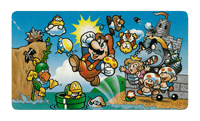
|
Super Mario Bros. | [Arm, Leg] - Attack +15 Usable by: Mario, Luigi, Yoshi, Peach, Bowser |
Quotes
- "We wanted to make a big Mario running around beneath a blue sky. We squeezed as much as we could out of the NES technology." — Shigeru Miyamoto, Super Mario History 1985-2010 Booklet
- "Developing this game was fun because it felt like we were solving a puzzle as we were making it." — Takashi Tezuka, Super Mario History 1985-2010 Booklet
- "There was so much enthusiasm on this project because we were trying to create something that had never been done before." — Koji Kondo, Super Mario History 1985-2010 Booklet
- "Thank you Mario! But our princess is in another castle!" — Mushroom Retainer, Super Mario Bros.
- "Thank you Mario! Your quest is over. We present you a new quest." — Princess Toadstool, Super Mario Bros.
Names in other languages
| Language | Name | Meaning | Notes |
|---|---|---|---|
| Japanese | スーパーマリオブラザーズ Sūpā Mario Burazāzu スーパーマリオブラザーズ1[22] Sūpā Mario Burazāzu Wan |
Super Mario Bros. Super Mario Bros. 1 |
|
| Chinese (simplified) | 超级马力欧兄弟[?] Chāojí Mǎlì'ōu Xiōngdì |
Super Mario Bros. | |
| Chinese (traditional) | 超級瑪利歐兄弟[?] Chāojí Mǎlì'ōu Xiōngdì |
Super Mario Bros. | |
| Korean | 슈퍼 마리오브라더스[?] Syupeo Malio Beuladeoseu |
Super Mario Bros. |
Trivia
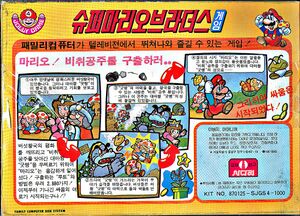
- Despite being unmentioned in the Japanese manual,[3] the Mushroom King appears in Asian-drawn strategy guide illustrations.
- The Guinness Book of World Records 2011: Gamer's Edition states that this game was also remade on the Nintendo 64,[23] which is incorrect.
- In a 2011 United States Supreme Court case, Brown v. Entertainment Merchants Association (which overturned a California law banning the sale of violent video games to children without parental supervision), the Electronic Frontier Foundation submitted an amicus brief citing social research that declared Super Mario Bros. to be a violent video game. In the brief, it was stated that the game contained cartoon violence similar to that found in various Saturday morning television shows, the Road Runner and Wile E. Coyote cartoons, and the Mighty Mouse series, which garnered little negative reaction from the public in their own times.[24][25]
- There was some controversy to Mario as well as the NES version of Super Mario Bros.,[26] with Mario, in particular, is noted as having a slight physical similarity to the Soviet dictator Joseph Stalin as well as replacing the Koopa flag (which resembled the Peace sign) with a flag that resembled the Soviet Red Star. Nintendo Power addressed this issue by trying to put Mario's mustache on Ivan Drago from Rocky IV and denying there was any intentional resemblance.[citation needed]
- A promotional artwork for the "Mario Pikachu" line of merchandise, based on the artwork for the Famicom release of Super Mario Bros., replaces the original game's characters and elements with Pokémon and elements from the Pokémon series. The changes are the following:
- Mario is replaced by Pikachu.
- Bowser is replaced by Blastoise.
- Princess Peach is replaced by Diancie.
- The Toads are replaced by two Foongus.
- The Koopa Paratroopa is replaced by a Wartortle.
- The castle is replaced by Bell Tower.
- A flower is replaced by Flabébé.
- The Goomba is replaced by a Shroomish.
- The Bullet Bill is replaced by Beldum.
- The Super Mushroom is replaced by a Big Mushroom.
- The Blooper is replaced by an Inkay.
- The hill is now orange and the Warp Pipe has been replaced by Slowpoke Well.
- The Koopa Troopa is replaced by a Squirtle.
- The Cheep Cheep is replaced by a Qwilfish.
- The Hammer Bro is replaced by a Psyduck.
- The cliff is now a cave.
- The Spiny is replaced by a Ferroseed, and the Lakitu is replaced by a Landorus.
References
- ^ Cite error: Invalid
<ref>tag; no text was provided for refs namednarelease - ^ インタビュー マリオ映画公開記念!宮本茂さんインタビュー 制作の始まりから驚きの設定まで (April 25, 2023). Nintendo Dream Web. Retrieved April 25, 2023
- ^ a b Legends of Localization comparing the Japanese and North American storylines of Super Mario Bros. (Retrieved April 30, 2014)
- ^ Ed Acosta. (Jan 25, 2015) Super Mario Bros a+start level restart. YouTube. Retrieved January 12, 2016.
- ^ YouTube video of "Minus World"
- ^ Several glitches on YouTube
- ^ https://www.nintendo.com/nes-classic/super-mario-bros-and-super-mario-bros-3-developer-interview
- ^ "Super Mario Bros. main character originally started out as...a huge square"
- ^ Iwata Asks: New Super Mario Bros. Wii: It Started With A Square Object Moving
- ^ Iwata Asks: New Super Mario Bros Wii
- ^ Nintendo (Nintendo of America) (June 16, 2015). Nintendo Digital Event @ E3 2015. YouTube. Retrieved June 19, 2015.
- ^ HSALS (May 22, 2015). EXCLUSIVE: Interview with Toru Iwatani, creator of Pac-Man. Geek Culture. Retrieved November 10, 2020.
- ^ shmuplations, "Koji Kondo – 2001 Composer Interview". Retrieved November 29, 2016
- ^ Supper Mario Broth (November 19, 2020). Twitter post showing hitbox, info sourced from TCRF. Twitter. Retrieved November 19, 2020.
- ^ https://www.gamekult.com/forum?foid=13000909, retrieved 6/4/2009
- ^ [1]
- ^ Super Mario Sales Data: Historical Units Sold Numbers for NES, SNES, N64... GameCubicle. Retrieved January 25, 2015.
- ^ Gigazine (November 9, 2019). "Super Mario Brothers Street" is born in Spain, pictures of Mario pleased at the commemoration ceremony. Gigazine. Retrieved August 20, 2019.
- ^ (October 27, 2003).ファミコン生誕20周年記念第2弾、「ホットマリオキャンペーン」が11月7日より開始!. Dengeki Online. Retrieved November 10, 2020.
- ^ Niizumi, H. (October 27, 2003). Nintendo puts original Super Mario on GBA. GameSpot. Retrieved November 10, 2020.
- ^ Nintendo Entertainment System – Nintendo Switch Online. Nintendo. Retrieved May 8, 2018.
- ^ (November 13, 2020). 『ゲーム&ウオッチ スーパーマリオブラザーズ』は本日発売。知っているとより楽しめる、”あそびのヒント”をご紹介。 Nintendo. Retrieved November 14, 2020.
- ^ https://www.pcworld.idg.com.au/slideshow/210299/guinness-world-records-gamer-edition/
- ^ Gene Hoffman. (September 27, 2010) How the Wrong Decision in Schwarzenegger v. EMA Could Cripple Video Game Innovation Xconomy. Retrieved October 12, 2022
- ^ https://www.eff.org/files/filenode/schwarzenegger_v/EFFPFFamicus.pdf Retrieved October 12, 2022
- ^ https://www.quora.com/Was-Mario-inspired-by-Stalin
External links
- Japanese website
- Nintendo UK Game Boy Advance site
- Japanese Famicom manual
- North American NES manual
| Super Mario Bros. / Super Mario Bros.: The Lost Levels / Super Mario Bros. Deluxe | ||
|---|---|---|
| Characters | Playable | Mario • Luigi |
| Unplayable | Mushroom King • Mushroom retainer • Princess Toadstool • Boo2 • Yoshi2 | |
| Worlds | Super Mario Bros. | World 1 • World 2 • World 3 • World 4 • World 5 • World 6 • World 7 • World 8 • Hard Mode |
| The Lost Levels | World 1 • World 2 • World 3 • World 4 • World 5 • World 6 • World 7 • World 8 • World 9 • World A • World B • World C • World D | |
| Misc. | Coin Heaven • Minus World • Sub-area • Warp Zone | |
| Items | 1 up Mushroom • Coin • Fire Flower • Magic Mushroom • Poisonous Mushroom1,2 • Red Coin2 • Starman • Yoshi Egg2 | |
| Objects | ? Block • 3-2-1 Block2 • Ax • Balance Scale • Beanstalk • Brick Block • Bridge • Buzzy shell • Cloud • Coral • Door1 • Dotted-Line Block2 • Face Block2 • Fireworks • Flagpole • Flimsy Lift • Hidden Block • Horsehair plant • Jumping board • Koopa shell • Lift • Pipe • POW Block3 • Small cloud • Staircase • Super Mushroom • Super Spring1,2 • Water • Wind1 | |
| Forms | Fiery Mario • Invincible Mario • Regular Mario • Super Mario | |
| Enemies and obstacles | Bloober • Bottomless pit • Bowser's Brother1,2 • Bullet Bill • Buzzy Beetle • Cheep-cheep • Enemy clone3 • Fire-Bar • Hammer Brother • Koopa Paratroopa • Koopa Troopa • Koopa's fire • Lakitu • Lava • Little Goomba • Piranha Plant • Podoboo • Sky Blooper1,2 • Spike Trap2 • Spiny • Spiny's egg • Turtle Cannon | |
| Bosses | Bowser • Fake Bowser | |
| Miscellaneous | Gallery (The Lost Levels · Deluxe) • Glitches (The Lost Levels) • Media • Pre-release and unused content • References in later media • Staff (Deluxe) • Super Mario Bros.: Mario Syndrome | |
| Related games | All Night Nippon: Super Mario Bros. • BS Super Mario Collection • Game & Watch: Super Mario Bros. • Super Mario All-Stars (+ Super Mario World · Limited Edition) • Super Mario Bros. 35 • Super Mario Bros. Special • VS. Super Mario Bros. | |
| Family Computer / Nintendo Entertainment System games | ||
|---|---|---|
| Super Mario franchise | Donkey Kong (1983) • Mario Bros. (1983) • Pinball (1984) • Golf (1984) • Family BASIC V3† (1985) • Wrecking Crew (1985) • Super Mario Bros. (1985) • Super Mario Bros. 2 (1988) • Super Mario Bros. 3 (1988) • Dr. Mario (1990) • NES Open Tournament Golf (1991) • Mario is Missing!* (1993) • Mario's Time Machine* (1994) | |
| Donkey Kong franchise | Donkey Kong (1983) • Donkey Kong Jr. (1983) • Donkey Kong Jr. + Jr. Sansū Lesson† (1983) • Donkey Kong Jr. Math (1983) • Donkey Kong 3 (1984) • Donkey Kong Classics* (1988) | |
| Yoshi franchise | Yoshi (1991) • Yoshi's Cookie (1992) | |
| Wario franchise | Wario's Woods (1994) | |
| Family Computer Disk System | Golf (1986) • Super Mario Bros. (1986) • Super Mario Bros.: The Lost Levels (1986) • I am a teacher: Super Mario Sweater (1986) • All Night Nippon: Super Mario Bros. (1986) • Golf: Japan Course (1987) • Golf: U.S. Course (1987) • Yume Kōjō: Doki Doki Panic (1987) • Famicom Grand Prix: F1 Race (1987) • Donkey Kong‡ (1988) • Famicom Grand Prix II: 3D Hot Rally (1988) • Donkey Kong Jr.‡ (1988) • Mario Bros. have returned‡ (1988) • Wrecking Crew‡ (1989) • Pinball‡ (1989) | |
| Miscellaneous | Nintendo World Championships 1990* (1990) • Nintendo Campus Challenge* (1991) | |
| Virtual Console games | ||
|---|---|---|
| Super Mario franchise | General | Mario Bros. • Mario's Super Picross • NES Open Tournament Golf • Super Mario Bros. • Super Mario Bros. 2 • Super Mario Bros. 3 • Super Mario Bros.: The Lost Levels • Super Mario Kart • Super Mario World • Wrecking Crew |
| Wii and Wii U | Mario Golf • Mario Kart 64 • Mario Party 2 • Mario Tennis (N64) • Paper Mario • Pinball • Super Mario 64 • Super Mario RPG: Legend of the Seven Stars | |
| Wii U and Nintendo 3DS | Mario Kart: Super Circuit • Mario vs. Donkey Kong • Yoshi's Island: Super Mario Advance 3 | |
| Wii U | Dr. Mario (NES) • Golf (NES) • Mario & Luigi: Partners in Time • Mario & Luigi: Superstar Saga • Mario Golf: Advance Tour • Mario Hoops 3-on-3 • Mario Kart DS • Mario Party Advance • Mario Party DS • Mario Pinball Land • Mario Tennis: Power Tour • Mario vs. Donkey Kong 2: March of the Minis • New Super Mario Bros. • Super Mario 64 DS • Super Mario Advance • Super Mario Advance 4: Super Mario Bros. 3 • Super Mario World: Super Mario Advance 2 • Wrecking Crew '98 | |
| Nintendo 3DS | Alleyway • Baseball • Dr. Mario (GB) • Golf (GB) • Mario & Luigi: Superstar Saga • Mario Golf (GBC) • Mario Tennis (GBC) • Mario's Picross • Picross 2 • Super Mario Bros. Deluxe • Super Mario Land • Super Mario Land 2: 6 Golden Coins | |
| Yoshi franchise | Tetris Attack • Yoshi (NES) • Yoshi's Cookie (NES) • Yoshi's Story | |
| Donkey Kong franchise | Donkey Kong • Donkey Kong (GB) • Donkey Kong 3 • Donkey Kong Country • Donkey Kong Country 2: Diddy's Kong Quest • Donkey Kong Country 3: Dixie Kong's Double Trouble! • Donkey Kong Jr. • Donkey Kong Jr. Math | |
| Wario franchise | Wario Land II • Wario Land 3 • Wario Land: Super Mario Land 3 • WarioWare, Inc.: Mega Microgame$! • WarioWare: Touched! • Wario's Woods (NES) | |
| Other | Game & Watch Gallery • Game & Watch Gallery 2 • Game & Watch Gallery 3 • Game & Watch Gallery 4 • Panel de Pon • Super Smash Bros. (N64) • Tetris (GB) | |
| Nintendo Switch Online games | ||
|---|---|---|
| NES | Super Mario franchise | Dr. Mario (2018) • Mario Bros. (2018) • Super Mario Bros. (2018) • Super Mario Bros. 3 (2018) • NES Open Tournament Golf (2018) • Super Mario Bros. 2 (2019) • Super Mario Bros.: The Lost Levels (2019) • Wrecking Crew (2019) • Pinball (2022) • Golf (2024) |
| Donkey Kong franchise | Donkey Kong (2018) • Donkey Kong Jr. (2019) • Donkey Kong 3 (2019) • Donkey Kong Jr. Math (2024) | |
| Yoshi franchise | Yoshi (2018) | |
| Wario franchise | Wario's Woods (2018) | |
| SNES | Super Mario franchise | Super Mario Kart (2019) • Super Mario World (2019) • Super Mario All-Stars (2020) • Mario's Super Picross (2020) • Wrecking Crew '98 (2024) |
| Donkey Kong franchise | Donkey Kong Country (2020) • Donkey Kong Country 2: Diddy's Kong Quest (2020) • Donkey Kong Country 3: Dixie Kong's Double Trouble! (2020) | |
| Yoshi franchise | Super Mario World 2: Yoshi's Island (2019) | |
| Other | Panel de Pon (2020) | |
| N64* | Super Mario franchise | Super Mario 64 (2021) • Mario Kart 64 (2021) • Mario Tennis (2021) • Dr. Mario 64 (2021) • Paper Mario (2021) • Mario Golf (2022) • Mario Party (2022) • Mario Party 2 (2022) • Mario Party 3 (2023) |
| Yoshi franchise | Yoshi's Story (2021) | |
| GB/GBC | Super Mario franchise | Super Mario Land 2: 6 Golden Coins (2023) • Game & Watch Gallery 3 (2023) • Dr. Mario (2024) • Mario Golf (2024) • Mario Tennis (2024) • Alleyway (2024) • Pinball (2024) • Super Mario Land (2024) |
| Wario franchise | Wario Land 3 (2023) | |
| Other | Tetris (2023) | |
| GBA* | Super Mario franchise | Super Mario Advance 4: Super Mario Bros. 3 (2023) • Mario Kart: Super Circuit (2023) • Mario & Luigi: Superstar Saga (2023) • Super Mario Advance (2023) • Super Mario World: Super Mario Advance 2 (2023) |
| Wario franchise | WarioWare, Inc.: Mega Microgame$! (2023) | |
| Yoshi franchise | Yoshi's Island: Super Mario Advance 3 (2023) | |
